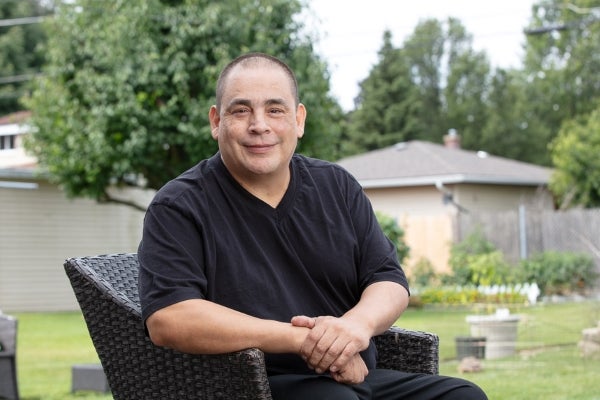Care for rare brain condition just 20 minutes from Rolling Meadows man’s home

When this Rolling Meadows, IL, man had a seizure during a business trip, the specialists at Ascension Alexian Brothers helped avert a stroke.
From left to right: Evelyn Badran, RN, John Spagnola, Karen Mnichowicz, RN, Ascension Alexian Brothers Gamma Knife® Center Manager and Donna Bynes, RN. (Not pictured is John's nurse, Jennifer.)
One of the perks of John Spagnola’s job installing commercial printers is he gets to see so much of the United States. On his last trip, for example, he drove through the stunning mountain vistas of Montana.
One place the 64-year-old Rolling Meadows, IL, man did not expect to visit during his travels was an emergency room. A rare brain condition caused him to have a seizure while in New Jersey for work, but the Neurosciences Institute at Ascension Alexian Brothers in Elk Grove Village, IL, helped prevent a potentially life-threatening stroke.
Intracranial dural arteriovenous fistula symptoms and diagnosis
John attended a conference in December 2022.
“Something wasn’t right. I was seeing flashes on both sides of my eyes. My depth perception was off,” John recalled. That night in his hotel room, he had a seizure that caused him to tumble out of his bed. Thankfully, his neighbor heard the noise and alerted the front desk, which got John to a nearby ER.
“When I woke up, a nurse was over me asking if I knew where I was,” John said. “My tongue hurt from where I’d bitten it. I didn’t remember any of it.”
A series of imaging scans revealed an intracranial dural arteriovenous fistula (dAVF) near the crown of John’s head.
“A dAVF is an unusual condition, and also a very dangerous one,” explained Timothy W. Malisch, MD, an Ascension Illinois neurointerventional surgeon who treated John at Ascension Alexian Brothers.
Normally, blood travels to your brain at high pressure through your arteries. There, it filters down to the tissue via smaller blood vessels called capillaries. After delivering oxygen to the brain, the blood is collected, at a low pressure, by the veins and carried back to the heart.
A dAVF, however, creates an abnormal connection between these veins and arteries. Arteriovenous fistulas do not always cause harm or need intervention, but if it reverses the flow so that high-pressure blood is being delivered to the brain through the vein, it is considered malignant.
“A malignant fistula, like the one John had, can be more dangerous than a brain aneurysm,” Dr. Malisch claimed. “It can cause seizures. It can cause vision problems. It can cause headaches. Most importantly, it puts you at a higher risk of stroke.”
John’s New Jersey care team sealed off the two main blood vessels upstream from the fistula using a glue-like material delivered via catheter, a procedure known as endovascular embolization. This would allow John to safely fly back to his home in Rolling Meadows, IL, but it was recommended that he check in with a brain specialist there.
Unfortunately, the procedure had not completely cut off the fistula’s blood supply. The seals were not close enough to the fistula, so John’s blood was still finding other pathways to it. As a result, John continued experiencing vision problems and seizures.
Getting to know the Ascension Alexian Brothers neurology team
John’s son-in-law was friends with Ascension Illinois neurosurgeon Bryan Bertoglio, MD. Through Dr. Bertoglio, John was soon introduced to the other specialists who would round out his care team: Dr. Malisch; Ascension Illinois neurosurgeon Szymon Rosenblatt, MD; Ascension Illinois neurologist Alkesh Patel, MD; and Patrick Sweeney, MD, a radiation oncologist affiliated with Ascension Illinois.
The Neurosciences Institute operates from a dedicated unit in Ascension Alexian Brothers, a certified Comprehensive Stroke Center and one of the few community hospitals with a Gamma Knife center in the state of Illinois.
John was given medication to prevent additional seizures while the team mapped out his brain’s circulatory system with imaging that included angiograms, MRI and CT scans. John appreciated how Dr. Malisch used this imaging as visual aids when explaining what the care team had in mind.
“Dr. Malisch explained everything in terms that I could understand, and I really felt that I was in great care,” John said.
“I think that most patients want to clearly understand what their health issue is; talking over their heads won’t reassure them,” said Dr. Malisch. “So I use a lot of visuals, drawings and language that I think they will understand.”
Gamma Knife radiosurgery and one more embolization
Dr. Malisch suggested that they move the glue from the New Jersey procedure closer to the fistula with a second embolization. And since John was otherwise healthy, he recommended they start with Gamma Knife radiosurgery.
Gamma Knife does not involve any incisions. Instead, it focuses tiny beams of radiation into a pinpoint. This makes it possible to target areas of the brain with extremely high precision, without damaging surrounding tissue. Gamma Knife makes it easier and safer to treat complex brain conditions such as cancer, tumors and lesions, but Dr. Malisch also finds that it helps put patients at ease.
“In a way, we are performing Plan A and Plan B at the same time, and that helps patients feel confident that they’re getting the right care,” he said.
If the embolization did not close off the blood flow to John’s fistula, the radiation from a single Gamma Knife session would cause those blood vessels to close over the coming years.
During the entire three-and-a-half-hour procedure, John was awake with his head secured inside a stereotactic headframe. This prevented John from moving his head while inside the Gamma Knife machine.
“It’s not an easy thing to sit still for that long, but at least I only had to do it once,” he said.
A few weeks later, John received his second embolization, which proved successful. His rate of recovery afterward still astonishes him.
“I had my embolization done on Monday, was released on Tuesday, worked from home Wednesday, and was back in the office Thursday,” he said. He hasn’t had a seizure, or even a headache, since."

John says thank you in danish (pastry) to his Gamma Knife care team
Don’t ignore potential stroke symptoms
By August, Dr. Malisch and his team had confirmed that John’s dAVF was completely gone.
“I'm a big believer that God cures our patients, but our team of well-trained doctors, nurses, radiation physicists and X-ray technologists helps,” Dr. Malisch said.
He also credits John for taking his symptoms seriously during his New Jersey conference. Dr. Malisch believes that educating patients on potential stroke symptoms helps them make life-saving decisions.
“Seek medical attention immediately if you suddenly have the worst headache of your life, or weakness in your arms or legs, or one side of your face sags,” Dr. Malisch emphasized. “Don’t take a nap and expect it to get better.”
John is back on the road for work and looks forward to a summer cruise with his wife along the Adriatic Sea. His gratitude for the care he received at Ascension Alexian Brothers inspired him to write a letter to the hospital’s president praising everyone on his care team. And when he comes by the hospital for a checkup, he likes to bring Danish pastries for his former nurses.
Even now, he gets a little choked up talking about all that they did for him. “To have this type of care within 20 minutes of my house is amazing.”
Vision problems, headaches and confusion can be early signs of a brain condition. Learn about neurological care options near you at ascension.org/ILbrainandspine
Last updated: October 14, 2024


